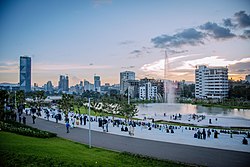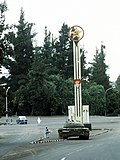Addis Ababa
Addis Ababa (also spelled Addis Abeba) is the capital city of Ethiopia.[3] It is also the political capital of the African Union.[4]
|
| |
| Coordinates: 9°1′48″N 38°44′24″E / 9.03000°N 38.74000°ECoordinates: 9°1′48″N 38°44′24″E / 9.03000°N 38.74000°E | |
| Country | Ethiopia |
| Chartered | 1886 |
| Government | |
| • Mayor | Adanech Abebe |
| Area | |
| • Chartered city | 527 km2 (203 sq mi) |
| • Land | 527 km2 (203 sq mi) |
| [1] | |
| Elevation | 2,355 m (7,726 ft) |
| Population (2008) | |
| • Chartered city | 3,384,569 |
| • Density | 5,165.1/km2 (13,378/sq mi) |
| • Urban | 3,384,569 |
| • Metro | 4,567,857 |
| Time zone | UTC+3 (East Africa Time) |
| HDI (2018) | 0.697[2] medium · 1st |
| Website | Official website |
History
Addis Ababa is both a city and a state. The city has people living in it from as many as 40 different countries speaking 80 different languages. There are many different communities in the city including Christian, Muslim, and Jewish communities. Addis Ababa is about 2,500 m above sea level. It has about five million people.
The site was chosen by Empress Taytu Betul. The city was founded in 1886 by her husband, Emperor Menelik II. The city is at the foot of Mount Entoto. In 1935 the city (renamed Addis Abeba) was conquered by the Italians and was made the capital of their empire in eastern Africa until 1941. Italians made huge improvements and modern projects to the city.
The city has grown since World War II and is now a huge metropolis that has nearly 9.98 million people living there as of 2019.
Addis Ababa University is in the city. Addis Ababa University was formerly known as Haile Selassie I University. It was named after the former Emperor of Ethiopia, who gave his palace to be used the main campus of the university in 1961.
Addis Ababa Media
Distant view of Menelik Palace in 1900
The earliest urban dwelling typically made up of hut cluster. Here is an example of British legation pictured in 1910.
The Te'eka Negist Mausoleum at Menelik Palace in Addis Ababa, 1934.
Tank in street of Addis Ababa shortly after the seizure of Ethiopian People's Revolutionary Democratic Front (EPRDF) from the Derg in 1991
Addis Ababa seen from the air, 2018
References
- ↑ "2011 National Statistics". Csa.gov.et. Archived from the original on 30 March 2013. Retrieved 20 July 2013.
- ↑ "Sub-national HDI – Area Database – Global Data Lab". globaldatalab.org. Retrieved 14 May 2020.
- ↑ "Ethiopia". travel.state.gov. 2011. Archived from the original on 2 November 2013. Retrieved 19 February 2011.
- ↑ "FDRE States: Basic Information, Oromia". The Federal Democratic Republic of Ethiopia. Archived from the original on 17 June 2008. Retrieved 29 May 2008.
Bibliography
- Beltrami, Vanni (2013). Italia d'Oltremare: Storie dei territori italiani dalla conquista alla caduta (in italiano). Rome Italy: Edizioni Nuova Cultura. p. 273. ISBN 978-88-6134-702-1. Retrieved 2017-12-20.
Related pages
Other websites
| Wikivoyage has a travel guide about: Addis Ababa |
- Addis Ababa City Administration Archived 2014-07-24 at the Wayback Machine
- Addis Ababa City Council Archived 2007-06-07 at the Wayback Machine
- Introduction to Addis Ababa Archived 2007-02-09 at the Wayback Machine
- Picture of Addis Ababa Archived 2007-07-11 at the Wayback Machine

















